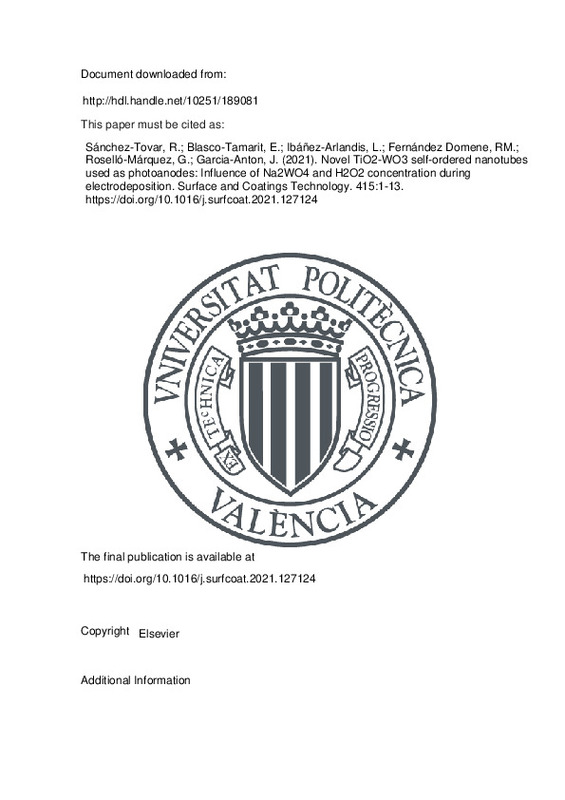JavaScript is disabled for your browser. Some features of this site may not work without it.
Buscar en RiuNet
Listar
Mi cuenta
Estadísticas
Ayuda RiuNet
Admin. UPV
Novel TiO2-WO3 self-ordered nanotubes used as photoanodes: Influence of Na2WO4 and H2O2 concentration during electrodeposition
Mostrar el registro sencillo del ítem
Ficheros en el ítem
| dc.contributor.author | Sánchez-Tovar, R.
|
es_ES |
| dc.contributor.author | Blasco-Tamarit, E.
|
es_ES |
| dc.contributor.author | Ibáñez-Arlandis, L.
|
es_ES |
| dc.contributor.author | Fernández Domene, R. M.
|
es_ES |
| dc.contributor.author | Roselló-Márquez, Gemma
|
es_ES |
| dc.contributor.author | Garcia-Anton, Jose
|
es_ES |
| dc.date.accessioned | 2022-11-03T10:38:22Z | |
| dc.date.available | 2022-11-03T10:38:22Z | |
| dc.date.issued | 2021-06-15 | es_ES |
| dc.identifier.issn | 0257-8972 | es_ES |
| dc.identifier.uri | http://hdl.handle.net/10251/189081 | |
| dc.description.abstract | [EN] Hybrid TiO2-WO3 nanostructures has been synthesized by electrochemical anodization under controlled hydrodynamic conditions followed by electrodeposition in the presence of different contents of Na2WO4 (5, 15 and 25 mM) and H2O2 (20, 30 and 40 mM). The influence of the electrolyte used for electrodeposition on the morphology, crystalline structure and photoelectrochemical response for water splitting has been evaluated through Field Emission Electronic Microscopy, High-Resolution Transmission Electron Microscopy, Confocal Raman Spectroscopy, Grazing Incidence X Ray Diffraction, X-Ray Photoelectron Spectroscopy, Atomic Force microscopy and photocurrent versus potential measurements. Additionally, a statistical multi-factor categorical analysis was performed to determine the most significant influential parameters. Results show that hybrid TiO2-WO3 nanostructures formed by simple anodization and subsequent electrodeposition with 30 mM H2O2 and 25 mM Na2WO4 present the highest photocurrent response, 60% higher if compared to TiO2 anodized nanotubes, solving the main problems presented during the usual fabrication of heterostructures, i.e. high temperatures, pressures, number of chemicals and time. | es_ES |
| dc.description.sponsorship | Authors thank for the financial support to the Generalitat Valenciana (Project Code: GV/2020/044) as well as to the project co-funded by FEDER operational programme 2014-2020 of Comunitat Valenciana (IDIFEDER/18/044). Authors also thank the Ministerio de Ciencia e Innovacion (Project Code: PID2019-105844RB-I00), for its help in the Laser Raman Microscope acquisition (UPOV08-3E-012) and for the cofinance by the European Social Fund. Authors also thank Alicia Mestre and Said Agouram from the SCSIE (Universitat de Val`encia) for their help with the XRD and HR-TEM measurements. | es_ES |
| dc.language | Inglés | es_ES |
| dc.publisher | Elsevier | es_ES |
| dc.relation.ispartof | Surface and Coatings Technology | es_ES |
| dc.rights | Reconocimiento - No comercial - Sin obra derivada (by-nc-nd) | es_ES |
| dc.subject | TiO2-WO3 nanostructures | es_ES |
| dc.subject | Anodization | es_ES |
| dc.subject | Electrodeposition | es_ES |
| dc.subject | Photoelectrocatalysis | es_ES |
| dc.subject | Water splitting | es_ES |
| dc.subject.classification | INGENIERIA QUIMICA | es_ES |
| dc.title | Novel TiO2-WO3 self-ordered nanotubes used as photoanodes: Influence of Na2WO4 and H2O2 concentration during electrodeposition | es_ES |
| dc.type | Artículo | es_ES |
| dc.identifier.doi | 10.1016/j.surfcoat.2021.127124 | es_ES |
| dc.relation.projectID | info:eu-repo/grantAgreement/AEI/Plan Estatal de Investigación Científica y Técnica y de Innovación 2017-2020/PID2019-105844RB-I00/ES/NANOTECNOLOGIA ELECTROQUIMICA PARA APLICACIONES CATALITICAS EN LOS CAMPOS MEDIOAMBIENTAL Y ALMACENAJE DE ENERGIA/ | es_ES |
| dc.relation.projectID | info:eu-repo/grantAgreement/MINECO//UPOV08-3E-012/ | es_ES |
| dc.relation.projectID | info:eu-repo/grantAgreement/GVA//GV%2F2020%2F044/ | es_ES |
| dc.relation.projectID | info:eu-repo/grantAgreement/GVA//IDIFEDER%2F2018%2F044//MODIFICACIÓN DE FOTOCATALIZADORES DE ÓXIDOS METÁLICOS NANOESTRUCTURADOS PARA LA ELIMINACIÓN DE FÁRMACOS Y PRODUCCIÓN ENERGÉTICA/ | es_ES |
| dc.rights.accessRights | Abierto | es_ES |
| dc.contributor.affiliation | Universitat Politècnica de València. Escuela Técnica Superior de Ingenieros Industriales - Escola Tècnica Superior d'Enginyers Industrials | es_ES |
| dc.contributor.affiliation | Universitat Politècnica de València. Instituto de Seguridad Industrial, Radiofísica y Medioambiental - Institut de Seguretat Industrial, Radiofísica i Mediambiental | es_ES |
| dc.contributor.affiliation | Universitat Politècnica de València. Instituto de Tecnología Eléctrica - Institut de Tecnologia Elèctrica | es_ES |
| dc.contributor.affiliation | Universitat Politècnica de València. Departamento de Ingeniería Química y Nuclear - Departament d'Enginyeria Química i Nuclear | es_ES |
| dc.description.bibliographicCitation | Sánchez-Tovar, R.; Blasco-Tamarit, E.; Ibáñez-Arlandis, L.; Fernández Domene, RM.; Roselló-Márquez, G.; Garcia-Anton, J. (2021). Novel TiO2-WO3 self-ordered nanotubes used as photoanodes: Influence of Na2WO4 and H2O2 concentration during electrodeposition. Surface and Coatings Technology. 415:1-13. https://doi.org/10.1016/j.surfcoat.2021.127124 | es_ES |
| dc.description.accrualMethod | S | es_ES |
| dc.relation.publisherversion | https://doi.org/10.1016/j.surfcoat.2021.127124 | es_ES |
| dc.description.upvformatpinicio | 1 | es_ES |
| dc.description.upvformatpfin | 13 | es_ES |
| dc.type.version | info:eu-repo/semantics/publishedVersion | es_ES |
| dc.description.volume | 415 | es_ES |
| dc.relation.pasarela | S\447313 | es_ES |
| dc.contributor.funder | European Social Fund | es_ES |
| dc.contributor.funder | Generalitat Valenciana | es_ES |
| dc.contributor.funder | Agencia Estatal de Investigación | es_ES |
| dc.contributor.funder | Ministerio de Economía y Competitividad | es_ES |







![[Cerrado]](/themes/UPV/images/candado.png)

